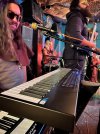- Joined
- Feb 11, 2023
- Messages
- 5
- Reaction score
- 0
I love my Roland Juno DS61, but I don't like the keys.
I use a lot of splits and layers, and I love how simple it is with the DS.
This keybed is too short for me, and it's too late to return the DS, so an external controller seems to be my only option.
I've purchased a few MIDI controllers to try out with my DS (Alesis V161, Nektar T6, Novation Launchkey 61, and Arturia Keylab), but I have concerns getting them to work with the splits and layers.
For instance, last night the Novation Launchkey 61 arrived.
I got the layers to work by setting every Patch in RxCH to "1".
I can't seem to find a way to get the Controller to identify splits.
95% of the Launchkey user guide is about Controller+DAW, there's nothing about Controller+Keyboard.
I have a few other controllers on the way, but I fear I'll have the same issue.
I've tried to research the problem, but most solutions are about fixing a Controller+DAW or Controller+PC issue, nothing about Controller+Keyboard.
I can imagine four outcomes here:
1. Order a MIDI Controller that just serendipitously works
2. Program the JUNO to work
3. Program the Controller to work
4. It's not possible
I'm hoping someone here has experience in this department and can lead me in the right direction.
Thanks for your time.
I use a lot of splits and layers, and I love how simple it is with the DS.
This keybed is too short for me, and it's too late to return the DS, so an external controller seems to be my only option.
I've purchased a few MIDI controllers to try out with my DS (Alesis V161, Nektar T6, Novation Launchkey 61, and Arturia Keylab), but I have concerns getting them to work with the splits and layers.
For instance, last night the Novation Launchkey 61 arrived.
I got the layers to work by setting every Patch in RxCH to "1".
I can't seem to find a way to get the Controller to identify splits.
95% of the Launchkey user guide is about Controller+DAW, there's nothing about Controller+Keyboard.
I have a few other controllers on the way, but I fear I'll have the same issue.
I've tried to research the problem, but most solutions are about fixing a Controller+DAW or Controller+PC issue, nothing about Controller+Keyboard.
I can imagine four outcomes here:
1. Order a MIDI Controller that just serendipitously works
2. Program the JUNO to work
3. Program the Controller to work
4. It's not possible
I'm hoping someone here has experience in this department and can lead me in the right direction.
Thanks for your time.


